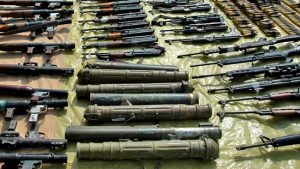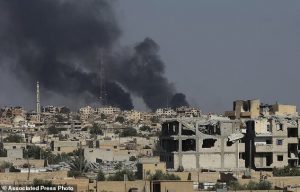 In an important victory for the Syrian people, the Syrian army and its allies have retaken control over Al Bukamal, the last significant stronghold of the Islamic State (ISIS or Daesh) in Syria. This victory has brought within sight an end to the nearly seven years of war which have devastated Syria.
In an important victory for the Syrian people, the Syrian army and its allies have retaken control over Al Bukamal, the last significant stronghold of the Islamic State (ISIS or Daesh) in Syria. This victory has brought within sight an end to the nearly seven years of war which have devastated Syria.
by Nita Palmer, Originally published on The Fire This Time
Civil War or Proxy War?
Although the conflict in Syria is referred to as a ‘civil war’ by the U.S. and their allies, in reality this war has been anything but. Years before fighting broke out, the U.S. government had been fomenting opposition to  the Syrian government under the guise of ‘democracy promotion’. In 2006, Time Magazine reported that “the Bush Administration has been quietly nurturing individuals and parties opposed to the Syrian government in an effort to undermine the regime of President Bashar Assad”, citing a classified document which notes that the U.S. is “supporting regular meetings of internal and diaspora Syrian activists” in Europe and hope that “these meetings will facilitate a more coherent strategy and plan of actions for all anti-Assad activists”. The classified document included a proposal to launch covert attempts to influence the 2007 Syrian elections in an effort to remove Assad from power.
the Syrian government under the guise of ‘democracy promotion’. In 2006, Time Magazine reported that “the Bush Administration has been quietly nurturing individuals and parties opposed to the Syrian government in an effort to undermine the regime of President Bashar Assad”, citing a classified document which notes that the U.S. is “supporting regular meetings of internal and diaspora Syrian activists” in Europe and hope that “these meetings will facilitate a more coherent strategy and plan of actions for all anti-Assad activists”. The classified document included a proposal to launch covert attempts to influence the 2007 Syrian elections in an effort to remove Assad from power.
As the fighting broke out in Syria in April 2011, the CBC reported that the U.S. State Department acknowledged it had been long funding opponents of the Syrian government, funneling over $12 million to anti-government activists and media organizations between 2006-2010. However, many of the groups which the U.S. was funding in the name of ‘promoting democracy’ were religious fundamentalists who formed the precursors to the terrorist organizations which operate in Syria today.
Syria was indeed facing internal problems in 2011 – as every country does. However, the war did not begin with Syrian government attempts to crush a peaceful grassroots uprising. The U.S. and their allies for years had been building an opposition to the Syrian government, and they seized their opportunity to create an armed conflict in the hopes of bringing down the Syrian government and president Bashar al-Assad.
The U.S. created the conditions for the deadly terrorists of Daesh to come to rise – and then began bombing and sending troops into the country under the guise of stopping the very terrorists they helped to create, all the while attempting to undermine the Syrian government, which was fighting tooth and nail to save their country from the terrorists. The consequences of this war have been devastating, and have turned what was once a modern and rapidly developing country into a living hell.
Sheer Destruction

Over 400,000 people have lost their lives in the war (UN, April 2016) and millions have been forced to flee their homes. The war has created the largest refugee crisis since World War II, with 5.7 million Syrians internally displaced and an additional six million having fled the country, often forced to live in miserable, overcrowded refugee camps or face the dangerous voyage to Europe. Many of those who fled had little time to gather their belongings, never mind say goodbyes to loved ones or put their affairs in order.
For those remaining in the country, conditions have grown more desperate. The Syrian economy has been deeply impacted by the war, with inflation rates skyrocketing. Basic necessities such as food and heating fuel are now out of reach for many Syrians. Between 2011 and 2015, the price of rice – a basic food staple – increased by 723%. In some areas, meat, and even vegetables, are available only on the black market.
Yet as prices have increased, available employment has become increasingly scarce. More than three quarters of working age Syrians are now unemployed or not actively employed (World Bank, July 2017). As a result, six in 10 people now live in extreme poverty, compared to just over one in 10 in 2007.
The country’s infrastructure has also suffered heavy damage. Many roads have been destroyed by bombs and the resulting debris and critical infrastructure for electrical and water delivery has been destroyed. Power generation declined by 62.5% between 2010-2015, resulting in rolling blackouts or sometimes no power at all in regions which once had round-the-clock electricity. Water access has become increasingly scarce, with a 50% decline in access to clean water. According to the World Bank, “Overall, nearly two-thirds of the water treatment plants, half of the pumping stations, a third of the water towers, a quarter of the sewage treatment plants, and a sixth of the wells have been destroyed or partially damaged across Syria”.
Lack of running water and sanitation facilities impacts more than just families trying to go about their daily lives; it also means schools cannot function, hospitals cannot provide basic care and businesses are forced to shut their doors.
Healthcare
A few short years ago, Syria’s healthcare system was known as one of the best in the region, and was rapidly advancing. Today, much of it has been decimated through physical damage, lack of security, and the utter chaos caused by the war. Nearly half of Syria’s health care facilities have sustained damage, and 16% have been destroyed completely (World Bank, July 2017). The World Health Organization estimates that two-thirds of Syria’s healthcare professionals have fled the country. In the areas hardest hit by the war, the losses are even greater. In the city of Aleppo – which was a stronghold of terrorist groups for much of the war – just 70 of the city’s 6,000 doctors remained as of 2014. In some areas, medical students or even veterinarians are the only ones left to provide medical care.
Of course, the violence and destruction caused by the war has made the loss of medical professionals an even more acute crisis. With the limited resources remaining, doctors and nurses scramble to treat the injured and face new outbreaks of disease due to lack of sanitation facilities and limited vaccination programs. Polio – which was considered eliminated in Syria – has now re-emerged.
As a result of this crisis, many who desperately need care – especially the elderly and those with chronic illnesses – have died. An estimated 200,000 Syrians have died from lack of access to drugs or medical care.
Education and the Lost Generation
Perhaps one of the greatest crises of this war is the lost generation of Syrian children and youth. As of 2009, 93% of Syrian children were enrolled in school. Today Syria has the second worst school enrollment rate in the world, with 2.8 million children out of school (Save the Children, 2014). The World Bank reports that over half of Syria’s schools are damaged, and 10% have been completely destroyed. School closures, lack of security, and the trauma of war have deeply affected the ability of Syrian children to receive an education. According to the International Rescue Committee (IRC), most Syrian kids are up to six years behind in literacy and numeracy. Paul Frisoli, the IRC senior technical adviser for education, states, “This is quite alarming… in a country that really promoted the value of education we are now seeing severely low levels of literacy and numeracy, which can have a severe impact on children’s learning going forward.”
The trauma of war has had a deep impact on this generation of Syrian youth, which UNICEF warns is becoming a ‘lost generation’. The trauma and loss of opportunities for each child would be bad enough; but the loss of education for this generation will affect the entire country. An entire generation of Syrian doctors, engineers, teachers, and workers has been put more than half a decade behind in their studies, and will continue to suffer from post-traumatic stress disorder throughout their lives. This puts not only the future of the individuals, but the entire country, in jeopardy.
What Has Been Achieved?
The U.S. and their allies in NATO and other countries in the region supported the so-called ‘rebels’ in the name of defending ‘freedom,’‘democracy,’ and ‘human rights’. When their support for these rebels gave rise to Daesh, the U.S. began bombing the country and sending in troops in the name of fighting terrorism.
Yet has this war, with all its costs and devastating consequences, achieved a single one of these goals? Far from it. Where are the human rights for those who have lived under the deadly reign of terrorists, forced to comply with their ideology or risk torture or public execution? Where are the human rights for the millions of Syrians who have been forced to flee their homes, their families, and their lives for an uncertain future in squalid refugee camps?
What democracy is there for those who have lived under the terrorists of Daesh or al-Nusra front? Where are the elections and ‘freedom of speech’ for those who have lived under their control?
What victory has there been over terrorism? The U.S. support for so-called ‘rebels’ gave rise to Daesh, the most widespread and deadly terrorist group in the world.The only victory over these terrorists has come at the hands of the Syrian army and their allies. Yet the damage has already been done – Daesh has spread and gained control of areas throughout the region.
The devastation and chaos the U.S. has created in Syria is no accident. U.S. intelligence agencies knew precisely what the consequences of supporting terrorist groups would be. The intervention in Syria is not a battle for human rights and democracy but part of a larger plan to sow chaos and division in the Middle East, in order for the U.S. and their allies to justify military intervention and establish more control in the region.
The U.S. aim is to replace the independent and secular government of Syria with one that follows U.S. interests in the region. This goal is part of a larger U.S. strategy to establish an upper hand over Iran, an important regional power which has stood independent from the U.S. since the Iranian revolution of 1979. Iran’s independence and insistence on control over their own resources, their own government, and their own future threatens U.S. economic and political interests in the region.
In 2006, the Bush administration established the Iran Syria Policy and Operations Group, a committee involving various members of U.S. government and intelligence agencies, to try and bring about regime change in Iran and Syria. This involved providing financial support to ‘dissident’ groups in Iran and Syria (some of which have now become the terrorist groups active today), military support to Gulf Arab countries allied with the U.S., and creating ‘economic development’ plans to strangle Iran’s economy. The group was disbanded after a year, but the same strategies have been adopted throughout the U.S.government.
Another important aspect of U.S. strategy in Syria and the larger Middle East and North Africa is to establish military and economic control ahead of rising global competitors such as China and Russia. If they can accomplish this through either direct or indirect intervention in a country they will; if not they will create long-term chaos in order to justify a long-term military presence, as they have done in Iraq and Afghanistan.
The U.S. plan to gain control over Syria by ousting President Assad and supporting terrorists has not gone quite as planned. The U.S. underestimated the level of support that Assad has within Syria and the ability of the Syrian army and their allies to fight back against the U.S.-sponsored terrorists. Be that as it may, we should not expect the U.S. government to give up on its campaign to control or create chaos in Syria anytime soon.
What is to Be Done?
What right does the U.S. have to decide the future of Syria, especially in light of all the destruction and chaos they have caused? Truly only Syrians have the right to decide the future of their country and their government. The way forward will not be easy after nearly seven years of war and the divisions which have been drawn by foreign interests, but it is the only path forward.
It is time for all U.S. and other uninvited foreign forces to leave Syria. The U.S. and their allies which were involved in this war and intervention must also be held responsible for the destruction of Syria. They supported the terrorists, created divisions in the country, and then destroyed the country, all with the excuse of stopping the very terrorists they created! This war has cost Syria not only hundreds of thousands of lives, but also put the future of the country in jeopardy and severely impacted the economy. The total cost to the Syrian economy thus far is $226 billion, according to World Bank estimates. The countries involved in creating this chaos should be held responsible to pay the Syrian people reparations for this amount, plus all other costs of damage created by the war.
The Syrian people have a long road ahead of them to rebuild their country and to stop the terrorists which have gained a foothold there.But they can only build a peaceful and democratic future for their country without foreign military intervention, meddling, and support for terrorists.
Follow Nita Palmer on Twitter: @NGP1z0
